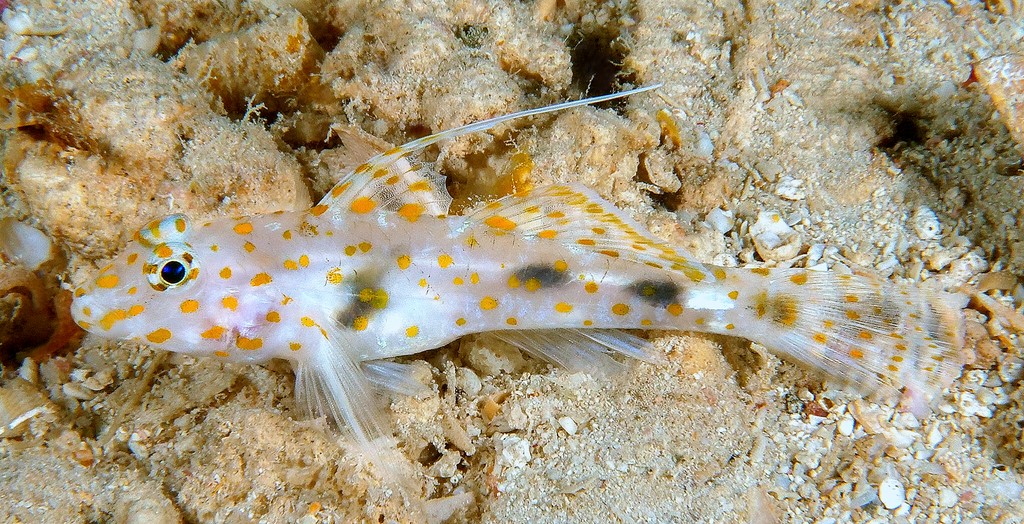FUSIGOBIUS INFRAMACULATUS - (RANDALL, 1994)
Picture courtesy of: Luc Faucompré
Innerspot sandgoby, Innerspotted sandgoby, Interspotted sandgoby, Blotched sand goby, Flasher goby, Orange-spotted sand goby, Orange-spotted sand-goby, Hatatate sankaku haze, ハタタテサンカクハゼ, 黃斑鯕塘鱧,
Synonyme
Coryphopterus inframaculatus (Randall, 1994)
-------------------------
Description
Dorsal spines (total): 7; Dorsal soft rays (total): 9; Anal spines: 1; Anal soft rays: 7-8; Pectoral fin rays: 19 Longitudinal scales: 25-26; Body depth: 4.8-5.2 in SL. Elongate and filamentous first two dorsal spines especially in male 67 % - 80 % length of first spine; Fully united pelvic fins; Presence of pelvic frenum; Rounded caudal fin; Ctenoid scales except cycloid on nape, breast and base of pectoral fin; Scales absent on operculum; Median predorsal scales absent; Opening of gill extending to below posterior half of opercle. Max. length: 4.6 cm SL. Depth range: 2 - 30 m.
Color
Semi-translucent body, presence of small orange spots, and 4-5 large internal blackish blotches and rectangular white marks; A subtriangular to oval black spot at midbase of caudal fin, its greatest diameter usually as large or larger than orbit diameter.
Etymology
Fusigobius: from Latin, fusus = spindle + from Latin, gobius = gudgeon.
inframaculatus: from Latin, infra = below, underneath, beneath + from Latin, maculatus = stain, make spotted.
Original description: Coryphopterus inframaculatus Randall, 1994 - Type locality: base of drop off, northeastern side of Jana Island, Persian Gulf, Saudi Arabia, depth 15 meters.
Distribution
Indo-West Pacific: East Africa and Persian Gulf east to Marquesas Islands, north to southern Japan, south to Queensland (Australia) and New Caledonia.
Biology
Solitary on sand at base of coral overhangs. Specimens collected from sand or sand and rubble substrata.
Synonyme
Coryphopterus inframaculatus (Randall, 1994)
-------------------------
Description
Dorsal spines (total): 7; Dorsal soft rays (total): 9; Anal spines: 1; Anal soft rays: 7-8; Pectoral fin rays: 19 Longitudinal scales: 25-26; Body depth: 4.8-5.2 in SL. Elongate and filamentous first two dorsal spines especially in male 67 % - 80 % length of first spine; Fully united pelvic fins; Presence of pelvic frenum; Rounded caudal fin; Ctenoid scales except cycloid on nape, breast and base of pectoral fin; Scales absent on operculum; Median predorsal scales absent; Opening of gill extending to below posterior half of opercle. Max. length: 4.6 cm SL. Depth range: 2 - 30 m.
Color
Semi-translucent body, presence of small orange spots, and 4-5 large internal blackish blotches and rectangular white marks; A subtriangular to oval black spot at midbase of caudal fin, its greatest diameter usually as large or larger than orbit diameter.
Etymology
Fusigobius: from Latin, fusus = spindle + from Latin, gobius = gudgeon.
inframaculatus: from Latin, infra = below, underneath, beneath + from Latin, maculatus = stain, make spotted.
Original description: Coryphopterus inframaculatus Randall, 1994 - Type locality: base of drop off, northeastern side of Jana Island, Persian Gulf, Saudi Arabia, depth 15 meters.
Distribution
Indo-West Pacific: East Africa and Persian Gulf east to Marquesas Islands, north to southern Japan, south to Queensland (Australia) and New Caledonia.
Biology
Solitary on sand at base of coral overhangs. Specimens collected from sand or sand and rubble substrata.
